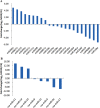Genome-wide identification and characterization of cadmium-responsive microRNAs and their target genes in radish (Raphanus sativus L.) roots
- PMID: 24014874
- PMCID: PMC3808317
- DOI: 10.1093/jxb/ert240
Genome-wide identification and characterization of cadmium-responsive microRNAs and their target genes in radish (Raphanus sativus L.) roots
Abstract
MicroRNAs (miRNAs) are endogenous non-coding small RNAs that play vital regulatory roles in plant growth, development, and environmental stress responses. Cadmium (Cd) is a non-essential heavy metal that is highly toxic to living organisms. To date, a number of conserved and non-conserved miRNAs have been identified to be involved in response to Cd stress in some plant species. However, the miRNA-mediated gene regulatory networks responsive to Cd stress in radish (Raphanus sativus L.) remain largely unexplored. To dissect Cd-responsive miRNAs and their targets systematically at the global level, two small RNA libraries were constructed from Cd-treated and Cd-free roots of radish seedlings. Using Solexa sequencing technology, 93 conserved and 16 non-conserved miRNAs (representing 26 miRNA families) and 28 novel miRNAs (representing 22 miRNA families) were identified. In all, 15 known and eight novel miRNA families were significantly differently regulated under Cd stress. The expression patterns of a set of Cd-responsive miRNAs were validated by quantitative real-time PCR. Based on the radish mRNA transcriptome, 18 and 71 targets for novel and known miRNA families, respectively, were identified by the degradome sequencing approach. Furthermore, a few target transcripts including phytochelatin synthase 1 (PCS1), iron transporter protein, and ABC transporter protein were involved in plant response to Cd stress. This study represents the first transcriptome-based analysis of miRNAs and their targets responsive to Cd stress in radish roots. These findings could provide valuable information for functional characterization of miRNAs and their targets in regulatory networks responsive to Cd stress in radish.
Keywords: Cadmium stress; Raphanus sativus; degradome; high-throughput sequencing; microRNAs; transcriptome..
Figures







References
Publication types
MeSH terms
Substances
LinkOut - more resources
Full Text Sources
Other Literature Sources

